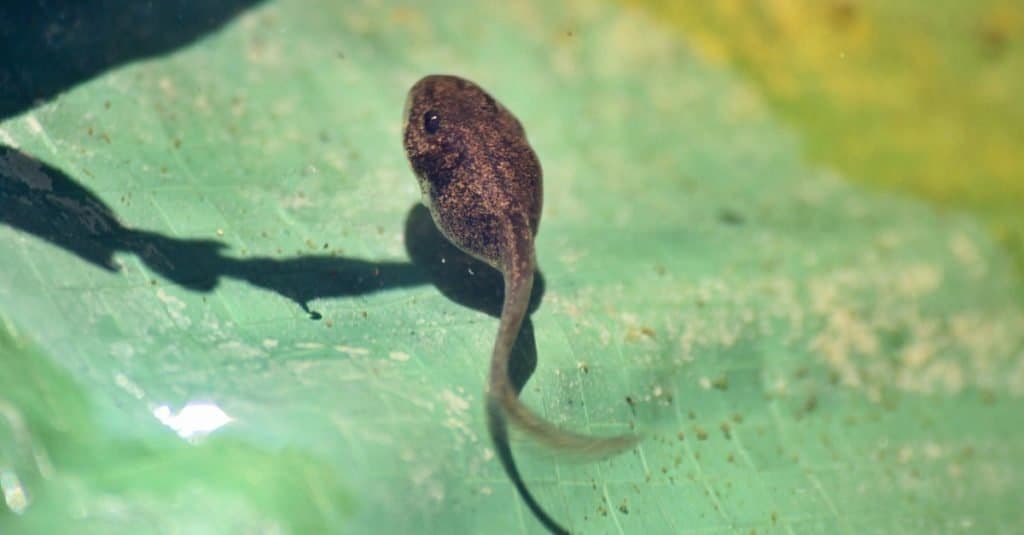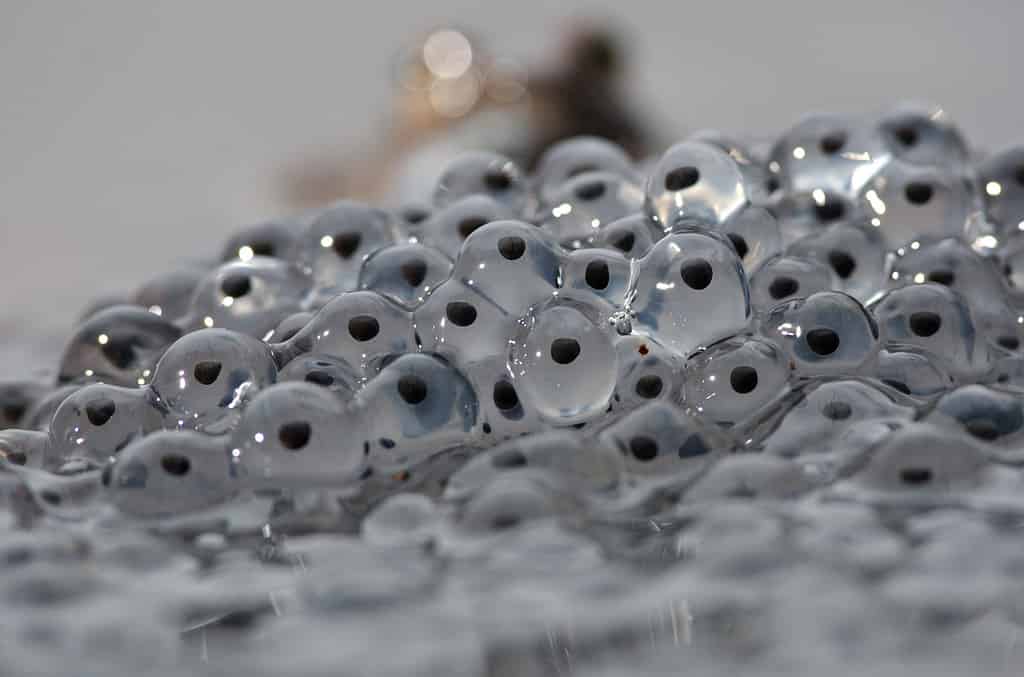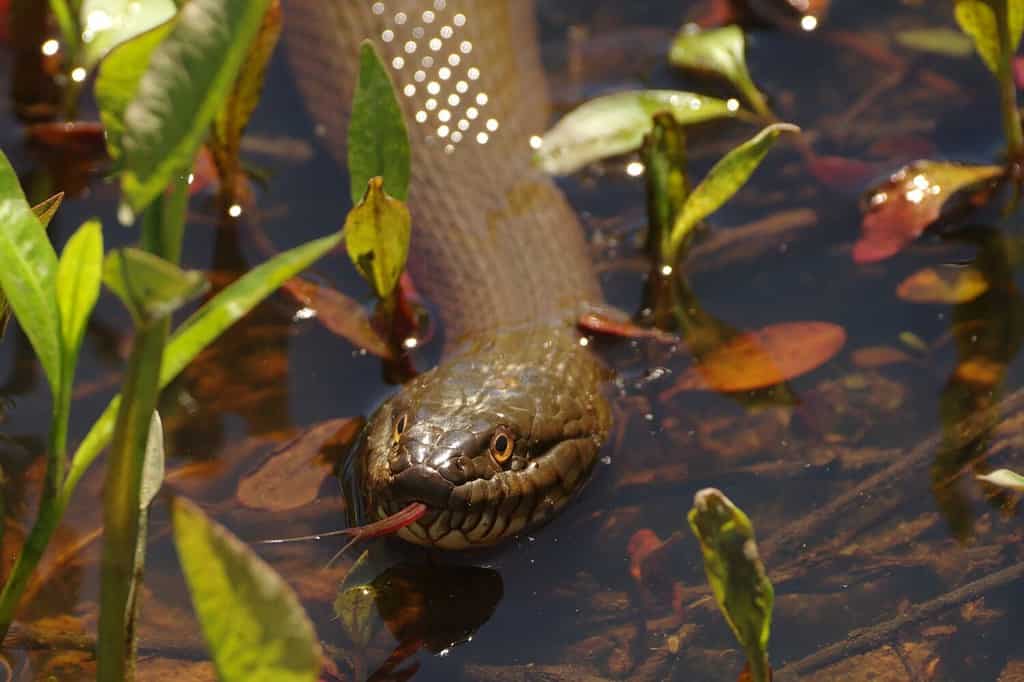Pollywog vs. Tadpole, are they the same thing? If you’ve typed this question into Google, you’re not alone. It’s a common question and a sensible one at that. The names are vastly different, but do they mean the same creature, or is a tadpole different from a pollywog? This article takes a look at just that. Keep reading to discover whether Granny’s pollywog is a tadpole.
Pollywog vs Tadpole: Are They the Same Thing?
Yes, pollywogs and tadpoles are the same thing.
The name tadpole comes from taddepol, which is Middle English for tadde, ‘toad,’ and pol, ‘head.’ Pollywog is Middle English too. It’s pol, ‘head,’ and wiglen, ‘to wiggle.’ Pollywog is interchangeable with polliwog and polwygle.
Are you wondering what Middle English is? It’s the English language spoken between 1066 and the 1500s.

A pollywog is a tadpole, which is an amphibian such as a frog, toad, or salamander’s larval stage.
©greggnormal/Shutterstock.com
What Is a Pollywog?
A pollywog is a tadpole, which is an amphibian such as a frog, toad, or salamander’s larval stage. It’s the stage between egg and adult form.
Tadpoles appear in the fossil record from Libros, Spain, and date back to the Miocene era, around 23.03 to 5.3 million years ago. They are rare finds because tadpole bodies are soft. They don’t have hard parts such as bones that preserve well. Carbon film, calcium carbonate, and calcium phosphate preserved Libros’s ancient pollywogs.
Pollywog vs. Tadpole: Appearance
Most tadpoles are black or dark brown and limbless but sport a tail longer than their head length.
Toad and frog tadpoles’ have rounded, bulbous heads and a tail that undulates laterally. They have external skin-covered gills to breathe underwater, and many species have a ‘cement’ gland that newly hatched pollywogs use to grip solid objects.
Depending on the species, tadpoles range from 1.3 inches long. Pseudis paradoxa is the longest tadpole. It can reach 11 inches before developing into a 1.3-to-3-inch adult.
Frog tadpoles: Many have bulbous heads with mottled brown or gray sides and a darker tail stripe. Some species’ tails are just as wide as their heads, whereas other species have skinny tails.
Toad tadpoles: Usually plain dark brown or black, but in contrast to frog tadpoles, they have rounded, chubby bellies.
Salamander tadpoles: Dark brown or black with streamlined heads that appear smaller than bulbous frog pollywog heads. Salamander tadpoles remain streamlined, skinny creatures. Their back feet develop first, and the tail stays put, whereas frog and toad tadpoles’ tails vanish as they develop.
Pollywog: Diet
Pollywog’s diet depends on the species. Frogs, toads, and salamander amphibians develop through a pollywog larval stage and prefer different diets as they metamorphose.
Frog and toad tadpoles are chiefly herbivores. They eat plankton and decaying plant matter, such as duckweed, and have long spiral-shaped guts to digest it. However, during shortages, frogs and toad tadpoles eat anything they can find in the water, including insects and carrion. The frog Ceratophryidae family are carnivores. They swallow flies, aquatic insects, worms, and younger pollywogs whole.
Carnivorous salamander tadpoles eat daphnia, mosquito larvae, and worms. These tadpoles are excellent predators in mosquito-prone gardens.
Here’s a list of what most tadpoles eat, just in case you’re looking to feed the cuties in your backyard but don’t know the species yet.
- Aquatic plants
- Algae
- Vegetation
- Larvae
- Worms
- Insects
- Carrion
- Plankton
- Other tadpoles
In an overcrowded water source, tadpoles may resort to cannibalism. To prevent it and help as many frogs, toads, and salamanders as possible, you could offer chopped greens, minced beef, or mealworms. Don’t overdo it, though. Only offer as much as the pollywogs eat; otherwise, leftover food rots and pollutes the water.
Pollywogs don’t have good vision. Researchers believe they can distinguish some colors and light changes but not to the extent of an adult. Instead, they rely on touch and scent to hunt out their food. A tadpole’s head is chock full of touch-sensitive neurons.
Tadpole Habitat
Tadpoles develop from eggs laid in ponds, slow-moving rivers, lakes, puddles, and wetlands.
Although tadpoles chiefly inhabit freshwater systems, some cope with salt conditions, particularly coastal species such as the mangrove swamp-dwelling crab-eating frog that’s tough enough to cope with saltwater-deluged mangrove swamps.
Tadpole Lifecycle
A tadpole (or pollywog) lifestyle is complex. Like butterflies and moths, metamorphosis transitions amphibians from egg to tadpole to adult.

Frog eggs look like eyeballs, and they have no shells.
©Marco Maggesi/Shutterstock.com
Eggs
Frog eggs look like eyeballs, and they have no shells. A black dot in the center is the developing tadpole, and a transparent jelly-like protective sphere surrounds it. Frog spawn, as it’s called, rests in squishy rounded clumps with up to thousands of eggs inside.
In contrast, toad eggs appear in straight lines, often strewn around vegetation for support. Cane toads lay over 30,000 eggs in one year!
Salamander eggs are different. Their eggs appear milky white or clear, occasionally turning green. Depending on the salamander species, eggs are rounded or cylindrical. Female salamanders lay up to 90 eggs in crevices, beneath stones, or decaying damp logs.
Tadpole
Tadpoles, also known as pollywogs, hatch from an egg with a tail and use it to propel themselves through the water. Over a few weeks, tadpoles develop legs and land-enabled lungs. Frog and toad tadpoles grow back legs first, followed by front legs. Then, the tail is absorbed via apoptosis.
As their legs develop, lungs begin to grow, and tadpoles begin to gulp air from the surface. A tadpole’s mouth transforms from a small, enclosed mouth into one as wide as its head at this point.
The final stage is intestinal. Their guts shorten to transition from herbivores into carnivorous adults called froglets.
The process from tadpole to froglet takes 12-16 weeks, depending on species and temperature. In cold climates, it may take up to eight months. If the weather is cold, tadpoles won’t transform but simply remain a tadpole until the water warms up again.
- 0-4 weeks = gills and tail but no legs
- 4-16 weeks = developing back and front legs and disappearing tail
- 16 weeks = fully formed froglet
However, if it’s chilly outside, a tadpole development slows, so a pollywog with front and back legs may be older than 12 weeks in cold areas.
Adults
Once their lungs and limbs have developed and their gills disappear, pollywogs become fully formed miniature versions of the adult.
Adult amphibians live near water or return to the water to lay eggs and continue the lifecycle. Many frogs and toads return to the pools they developed in once they reach three-year maturity.
Pollywog vs. Tadpole: Predators
Many animals prey on pollywogs. Their nutritious bodies fuel carnivorous fish, birds, snakes, turtles, newts, dragonfly larvae, rats, foxes, and hedgehogs. They don’t have a lot of defenses, but some tadpole species shoal together to create safety in numbers.
Humans eat tadpoles, too. In China, four-inch-long megophyrid frog tadpoles are a delicacy. Tadpole medicines and food is popular in India and Peru as well.

Their nutritious bodies provide fuel to carnivorous snakes and other creatures.
©Philip Yabut/Shutterstock.com
Why Do Tadpoles Gasp at the Surface?
It’s not uncommon for pollywogs to gasp at the surface. Here are two reasons why.
Developmental Stage: Tadpoles turning into froglets develop lungs and stop using their gills. To strengthen their lungs, they gasp air from the water’s surface.
Polluted Water: Or it may be the water is too hot and too polluted to contain much oxygen. If this is the case, consider adding oxygenating plants.
Are They the Same Thing? Pollywog vs. Tadpole Recap
Pollywog and tadpole refer to the larval stage of frogs, toads, and salamanders. Although the larvae differ slightly in appearance and diet, they are developing adults.
In general, older folk tend to use the term pollywog more than a tadpole. The two were interchangeable years ago (and still are), but schools chiefly teach the name tadpole these days, so that makes pollywog an alien word to some.
However, now you know the truth! In its larval stage, a tadpole and a pollywog are the same names for a developing frog, toad, or salamander.
The photo featured at the top of this post is ©
Thank you for reading! Have some feedback for us? Contact the AZ Animals editorial team.






